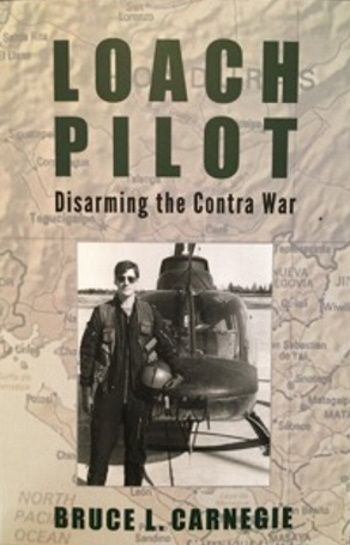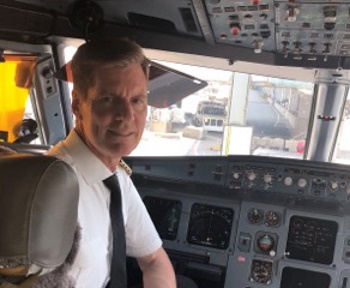Loach Pilot
Disarming the Contra War. Author, Bruce L. Carnegie.

Book Review by Col. Chris Shelly
Disarming the Contra War is Bruce Carnegie's memoir of his time as a CH139 Jet Ranger pilot with 89 Rotary Wing Aviation Unit (RWAU) in Central America during the first half of 1990. It is a refreshing and exciting read, that portrays vividly the challenges Canadian pilots faced in that theatre. As there are few accounts of Canada's mission in support of the United Nations (UN) demobilization of the Contra rebels, it is a story that needs to be told, and Bruce throws a new light on the interesting characters Canadian peacekeepers worked with in situations that were often more bizarre than dangerous. This reviewer flew on that mission and can attest to the reality of what is described.
As 1990 dawned, Canada still harboured its illusions about peacekeeping. The Berlin Wall had fallen and new possibilities for reshaping the post-Cold War landscape were within reach. In Central America, the United States and the Soviet Union cooperated briefly to dismantle proxy armies that had their means for superpower competition throughout the 1980s. Nicaragua had suffered guerrilla warfare for most of the decade, with the Americans supporting the Contra rebels against the Soviet-backed Sandinista government that had ousted the oppressive Somoza dictatorship.
In 1989 the UN agreed to deploy an Observer force into Central America to facilitate a peace settlement. Canada, ever eager to be the "useful fixer," agreed to provide Military Observers and logistic support in the shape of a small helicopter unit to be based in Tegucigalpa, Honduras. Although the planned ceasefire was not yet in effect, the unit began to deploy in January 1990, ready to support the observer force, known as ONUCA. Events moved rapidly, as a plan for a ceasefire and demobilization was agreed to in March 1990. The UN expanded the force with a battalion of Venezuelan infantry and Canada agreed to provide additional helicopters and observers. The unit, 89 RWAU, grew from four CH139 Jet Rangers with the addition of four CH135 Twin Hueys. 89 RWAU also coordinated the support of an additional eight contract helicopters: four Allouettes and four Bell 212s. 89 RWAU would have a short but exciting history, folding up by December 1990. 427 Squadron provided the unit's core, augmented by personnel and aircraft from 408 Squadron, Edmonton.
LOACH Pilot is a first-person account of Bruce's adventures flying the Jet Ranger in Central America. For adventures they were! Bruce, a Captain with 427 Squadron, Petawawa, flew the CH136 Kiowa light observation helicopter, (LOH), commonly referred to as a "LOACH" in military jargon. Tapped to be the Deputy Operations Officer (DOpsO) of the new unit, he was deeply involved in organizing the deployment and the establishment of the unit in its new home, Toncontin International Airport, in the capital of Honduras, Tegucigalpa. First pilot to deploy, Bruce saw the mission evolve from a very disorganized start to its apex, the successful disarmament of Contra forces in Honduras and Nicaragua, in July 1990. For the first time, Canadian air force helicopters flew in an active conflict zone, placing themselves between the two warring parties in the hope that the mere presence of a UN mission could jump-start peace negotiations.
In the beginning, this was accomplished by a small group of four Canadian Forces Jet Rangers and four civilian Alouette III contracted machines, which provided critical command and liaison capabilities to the UN staff and observers. Bruce recounts how the standard CH136 Kiowa helicopters of 10 Tactical Air Group lacked the power for the high and hot environment of Central America, so more powerful CH139 Jet Ranger helicopters were hastily withdrawn from the helicopter training school at Portage la Prairie and pushed into front-line service with 89 RWAU.
Bruce fills the pages with exciting accounts of his missions. There is an early encounter with the realities of the Contra war, as Bruce and his crewman land at an observer post crammed with Contra casualties from a recent battle. As demobilization progressed, the Contra rebels took to firing random shots at UN helicopters, making approaches into Contra-held locations quite sporting, to say the least. Later, 89 RWAU created a detachment in Managua, Nicaragua, where Bruce got a close look at the other side of the coin, the Nicaraguan people, and the Sandinista army. Each day brought new adventures as Canadians ranged far and wide across the conflict zone in their helicopters, never knowing what might happen and meeting head on the challenge of demobilizing the rebel forces. Bruce concludes with a riveting account of a nighttime casualty evacuation mission from the Gulf of Fonseca, where he and his observer crewman pulled out all the stops to fly a gravely wounded UN observer directly into the Tegucigalpa hospital.
Canadian helicopter crews made operational decisions on the spot as they ranged across the theatre, and no day was like another. The difference between the tightly controlled environment of 10 Tactical Air Group in Canada and the free-wheeling helicopter operations of 89 RWAU in Central America was like night and day. Let off of their leash, the aircrew thrived in an environment where mission accomplishment trumped every other consideration.
Along the way, Bruce paints an interesting picture of the unit and his comrades. 89 RWAU was unique, in that the personnel lived among the Honduran population, renting houses and cars, restricted to flying during daylight hours except in emergencies. 30 years on, Bruce looks back maturely on some of the decisions made by his superiors and some of the stranger events of the tour.
As a memoir, the story is Bruce's alone and sometimes suffers from the defect of memory. For example, the addition of four Bell 212 contract helicopters from Evergreen Helicopters early in the tour is completely omitted, although as Deputy Operations Officer, Bruce was responsible for tasking these aircraft. Nor does he mention the withdrawal of the ALQ-44 infrared jammer from use early in the tour, even though this move by the commanding officer was extremely controversial and nearly led to a mutiny. However, these lapses detract little from the book's value. The essence is the thing, and Bruce captures the spirit of the unit and its mission very well. Historians will find Bruce's memoir a useful starting point for investigation, a colourful supplement to the official documents about Canada's mission in Central America. While more deserves to be written about the contribution of Canada's airforce to peace in Central America, "LOACH Pilot: Disarming the Contra War," is a good starting place for Canadians interested in learning more and is well worth the purchase.
